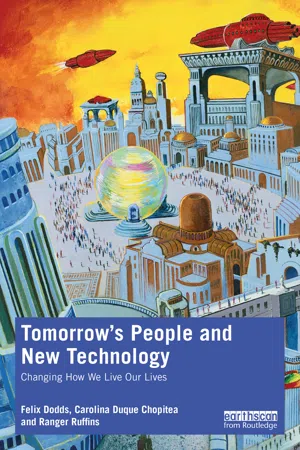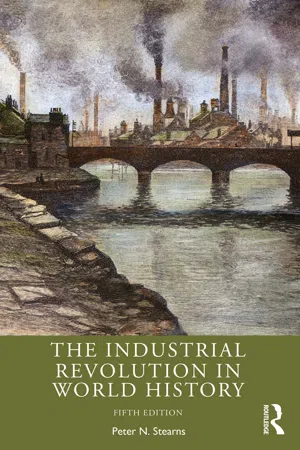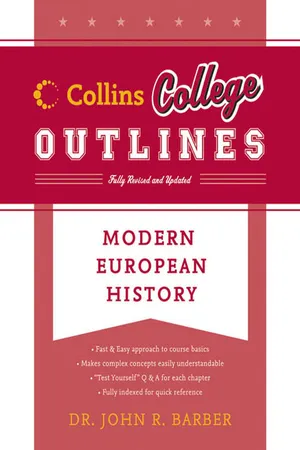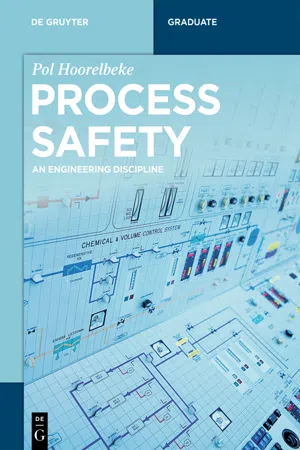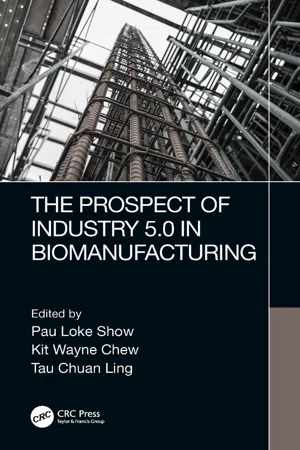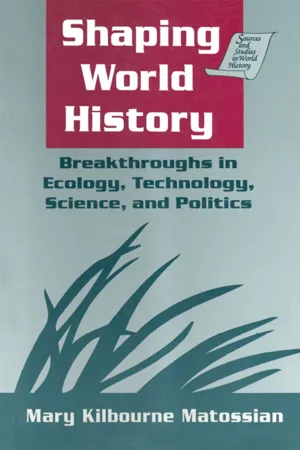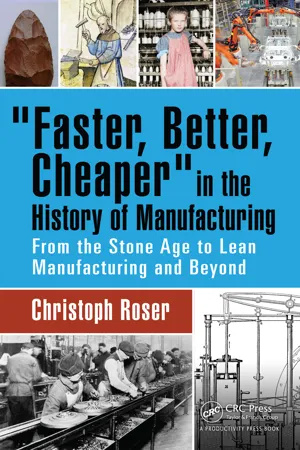History
First Industrial Revolution
The First Industrial Revolution, which began in the late 18th century, marked a significant shift from agrarian and handcraft-based economies to industrial and machine-based production. Key innovations during this period included the steam engine, mechanized textile production, and the development of iron and steel industries. This revolution transformed society, leading to urbanization, increased productivity, and the rise of factory-based manufacturing.
Written by Perlego with AI-assistance
Related key terms
Related key terms
1 of 4
Related key terms
1 of 3
11 Key excerpts on "First Industrial Revolution"
- eBook - ePub
Tomorrow's People and New Technology
Changing How We Live Our Lives
- Felix Dodds, Carolina Duque Chopitea, Ranger Ruffins(Authors)
- 2021(Publication Date)
- Routledge(Publisher)
The term ‘Industrial Revolution’ was popularised by English writer Arnold Toynbee in the late 1880s. Toynbee’s lectures on the Industrial Revolution, published in 1884, were the first and most influential attempts to historicise the transition to a machine-based economy, particularly in Britain (Wilso, 2014). This term was later used to describe not one but four distinct periods of industrial revolution throughout history.Klaus Schwab, founder and executive chairman of the World Economic Forum (WEF), describes an industrial revolution as the emergence of:New technologies and novel ways of perceiving the world [that] trigger a profound change in social and economic structures. (Schwab, 2017A)Simply put, industrial revolutions are the intersection of change between emerging technologies and the way humans live and perceive life.According to the Merriam-Webster dictionary, a revolution is a sudden, radical, or complete change, often in society and the social structure, frequently accompanied by violence. And industrialisation is the process by which an economy is transformed from a primarily agricultural focus to one based on the manufacturing of goods. Individual manual labour is often replaced by mechanised mass production, and craftsmen are replaced by assembly lines. Characteristics of industrialisation include economic growth, a more efficient division of labour, and the use of technological innovation to solve problems as opposed to dependency on conditions outside human control (Investopedia).It is hard to overstate the significance of the First Industrial Revolution – starting around 1760 to 1820. Up until that point, civilisation had made almost no economic progress for most of its existence, and suddenly there was a spike in social and economic progress. For most of human history, the economic growth rate was about 0.1 per cent per year, which allowed for a gradual increase in population but no growth in per capita living standards (Silver, 2012). - eBook - ePub
- Peter N. Stearns(Author)
- 2020(Publication Date)
- Routledge(Publisher)
The most revolutionary period of the industrialization process ends, however, when most workers and managers (whether in factories or smaller workshops) use some powered equipment and operate according to some of the principles of industrial organization. At this point, the larger society has gained an ability to apply industrial procedures to most branches of the economy, and although it may not have done so fully (as with the somewhat laggard French peasants), virtually every major group has faced some serious adjustment to the impact of the industrial revolution. Historically, this point has been reached seventy to one hundred years after serious technological innovation first began. Thus, for example, it is legitimate to peg the end of the U.S. industrial revolution at about 1920, when factory production overwhelmingly dominated other forms in manufacturing and when half the population lived in cities. Vast economic changes were to occur after 1920, extending the transformations the industrial revolution had wrought, but the industrial context was set.The definition of the industrial revolution, thus, includes a massive set of changes that begin when radical innovations in technologies and organizational forms are extensively introduced in key manufacturing sectors and that end, in the truly revolutionary phase, when these innovations are widely, though not necessarily universally, established in the economy at large. Subsequent changes, often quite unsettling, are virtually ensured, but they arise within the contours of an industrial society.But what, then, is an industrial society? This is a second definitional issue in expanding the idea of industrial revolution beyond its most basic elements. What kinds of social alterations followed from new machines, factories, stores, and offices? The industrial revolution was a systems change: New technology and organization boosted production and propelled manufacturing over agriculture as the industrial society’s greatest source of wealth and employment. To handle factory and related jobs, and because industrial machines began to take over some of the production previously performed in the countryside, cities grew rapidly. By 1850 half of Britain’s population lived in cities, the first such urban achievement in human history—for even the most effective agricultural societies had never been able to free more than 25 percent of a population from the rural economy.A systems change of this sort inevitably, though again gradually, affected every aspect of human and social life. Personal habits changed as people learned a new sense of time and discipline. The status of old people changed. The industrial revolution in Europe and the United States gave the elderly some new functions, such as babysitting for their working adult children, but it diminished their status: jobs became associated with high energy and the ability to learn new techniques, and the elderly were culturally downgraded because they seemed to lack these qualities. The industrial revolution changed the nature of war, too, as was obvious from the U.S. Civil War (1861–1865) onward: industrial war meant more rapid and massive troop movements, devastating weaponry, and greatly increased death and maiming in battle. - No longer available |Learn more
- John R. Barber(Author)
- 2011(Publication Date)
- Collins Reference(Publisher)
CHAPTER 2The Industrial Revolution (Early 1700s to Mid-1800s)1701: Jethro Tull invents the seed drill and greatly improves crop planting.1712: Thomas Newcomen builds the first modern steam-powered pumping engine.1717: One of the first true factories begins operation.1733: John Kay devises the flying shuttle for cloth weaving.1767: Richard Reynolds builds the first cast iron railway.1768: Richard Arkwright devises the water frame for powered thread production.1769: James Watt patents a much-improved version of the steam engine.1784: Henry Cort develops “puddling,” a better iron processing method.1807: Robert Fulton’s steamboat, the Clermont, first plies rivers in the United States.1825: The British Parliament legalizes the incorporation of businesses.1829: George Stephenson’s Rocket, a steam locomotive for railroads, completes a successful trial.1834: Several German states organize the Zollverein, a customs union led by Prussia.1844: The first telegraph message is sent over a line between Baltimore, Maryland, and Washington, D.C.1856: Henry Bessemer improves steel processing.A number of the new technological, economic, and social changes that remained subordinate in Early Modern Europe became prominent and had a drastic effect in England and northwestern Europe between the early 1700s and mid-1800s. As a result, people of that time and since have described this occurrence as an industrial revolution.Many of the technological instruments fashioned during this industrial revolution differed from the machines of the previous era in that inanimate power drove them. This transition from a predominantly human-and animal-powered agricultural life to a more urban economy of machine production and transportation was an outstanding trait of the Industrial Revolution. A multitude of sometimes hulking and noisy inventions thus appeared as typical elements of the new economic order. - eBook - ePub
Management, Organisations and Artificial Intelligence
Where Theory Meets Practice
- Piotr Buła, Bartosz Niedzielski(Authors)
- 2021(Publication Date)
- Routledge(Publisher)
1 Industrial revolution – from Industry 1.0 to Industry 4.0DOI: 10.4324/9781003184027-11.1 Genesis and development of Industry 4.0
From the evolutionary perspective, the development of Industry 4.0 started at the turn of the 18th and 19th centuries, with the transition from craft and manufacture production to mechanized factory production, which became the First Industrial Revolution (Industrial Revolution 1.0). A pioneer of those early transformations was James Watt, a Scottish engineer and inventor from Glasgow, who, in the winter of 1763, received a lucrative, though difficult to complete order regarding improvements in one of the first steam pumps in the UK (Pottin & Dietz, 2018). As it turned out later, for Watt the task became the idée fixe, which did not leave him in subsequent years. The inventor received help from a friendly plumber, whose involvement and – for those times – primitive tools resulted in the design of the steam engine, which was the device’s central drive unit. Watt’s achievement, which was an improvement on the atmospheric steam engine developed by Thomas Newcomen,1 was thereby regarded as a breakthrough in industrial technology and proclaimed a worldwide industrial revolution. In recognition of his achievement, in 1769 Watt was awarded his first patent by the King of England.In the context of the above, it should be noted that the First Industrial Revolution, beginning around 1760 and ending around 1840, was and is an important part in the world’s economic history, which paved the way for its future development. It began an era of mechanization and the use of a number of (at the time) innovative technical inventions, primarily for the production of energy. The changes that occurred at that time also revolutionized people’s thinking about the workplace and methods of performing work. With mechanization, it was possible to produce the same things in factories eight times faster than before. As a result, for the first time in the world’s history the individual and his/her “costly” work were being substituted by steam machines driven by cheap coal. From the economic point of view, this substitution led to reductions in the earlier costs of production and an almost exponential growth in work efficiency, which was reflected in related profits. Work automation related to the application of the steam machine in the mining industry, or later in textiles, was the largest breakthrough in the history of production. Importantly, the achieved effect was further strengthened by the discoveries that humanity experienced at the beginning of the 19th century, primarily James Neilson’s2 “hot blast” or George Stephenson’s3 - eBook - ePub
Process Safety
An Engineering Discipline
- Pol Hoorelbeke(Author)
- 2021(Publication Date)
- De Gruyter(Publisher)
This chapter described how society evolved in the period 1700 to 1900. Rapid population growth coupled with increased urbanization brought fundamental changes to the social system.More food had to be produced and the demand for new materials increased. Global trade accelerated, which in turn increased the demand for better roads, better and faster transport, a new banking system.These changes formed the basis of the transition to new manufacturing processes in Europe and the USA, now known as the First Industrial Revolution.This First Industrial Revolution created the demand for more and better machines, new materials, more energy, new products, etc., which resulted in the Second Industrial Revolution. The large land owners invested more and more money in new industries, factories and mines.The Second Industrial Revolution was a period of rapid industrial development, characterized by the construction of railroads, large-scale iron and steel production, widespread use of machinery in manufacturing, greatly increased use of steam power, widespread use of the telegraph, use of petroleum and the beginning of electrification. It also was the period during which modern organizational methods for operating large-scale businesses over vast areas started to be used.The Second Industrial Revolution gave rise to large industries that employed many people; these included construction of railways, textile factories, steel factories and coal mines.The social and economic changes that engulfed Europe in the nineteenth century were exceptional and never seen before. In 1850, the percentage of the population working in agriculture was 75% in Italy, 60% in Germany, 52% in France and 22% in Great Britain. The rapid industrialization brought these figures down at the turn of the century (1900) to 60% in Italy, 35% in Germany, 42% in France and 9% in Great Britain.The nineteenth century was the century of revolutions. The French Revolution of 1789–1799 was a political uprising that massively reduced the power and privileges of the nobility and the clergy. This political revolution which started in France spread over the entire continent. The traditional land-owner aristocracy was undermined by the forces of economic change and political reforms. A new hybrid social elite emerged based on citizen values such as economy, hard work, freedom, austerity, equality and responsibility. These values dominated society and politics in large parts of Europe and were reflected in sanitation and hygiene, reforms in criminal law and participation of the respectable working class. - eBook - ePub
The Global Economy
A Concise History
- Franco Amatori, Andrea Colli, Franco Amatori, Andrea Colli(Authors)
- 2019(Publication Date)
- Routledge(Publisher)
THE INDUSTRIAL REVOLUTION: TECHNOLOGY AND SOCIETYSUMMARY: 4.1. A long-term process. – 4.2. Foreign trade, empire, mercantilism. – 4.3. Early structural transformation. – 4.4. The technological revolution: stages, sectors and innovations. – Bibliography.4.1. A long-term processIn the 19th century, for the first time in history, rapid population growth in Europe and North America was accompanied by rapidly rising incomes and levels of productivity. The structure of the economy changed radically during the century, as a growing share of the population moved from agriculture into industry and services. In some sectors of the economy, family firms were replaced by joint-stock companies; trade became increasingly global and some radical changes affected social life and ideologies, such as urbanization and secularisation. On a world scale, growth spread in certain specific areas of the West, leading to a notable divergence in living standards between the developed and underdeveloped nations. In two centuries, Europe’s GNP multiplied by 50 and per capita income by almost 20. This new world, marked by geographical, environmental and social imbalances, would provide the context for modern economic development, and began to form with the First Industrial Revolution, which started in England and then spread through Western Europe and the United States during the central decades of the 19th century.Historians have underlined, however, that there was actually no dramatic acceleration in England’s GDP during the “classical” period (1760–1830). Despite extraordinary innovations, per capita economic growth during those decades was actually very small: 0.2–0.5%. Only industrial output grew more rapidly, perhaps between 2.6 and 3% according to the most optimistic estimates. This led to a debate, especially during the 1980s and 1990s, about the actual idea of “Industrial Revolution”, which was considered an inappropriate concept to describe such a gradual change.1 - eBook - ePub
- Pau Loke Show, Kit Wayne Chew, Tau Chuan Ling, Pau Loke Show, Kit Wayne Chew, Tau Chuan Ling(Authors)
- 2021(Publication Date)
- CRC Press(Publisher)
1.1 Industrial Revolution 1.0 and 2.0 Adrian Chun Minh Loy, Bridgid Lai Fui Chin, and Revathy SankaranCONTENTS1.1.1 Industrial Revolution 1.01.1.2 Industrial Revolution 2.01.1.3 Technology Development in Industrial 1.0 and 2.01.1.3.1 Textile1.1.3.2 Steam Engine1.1.3.3 Iron Production1.1.3.4 Chemicals1.1.3.5 Electricity1.1.3.6 Transportation1.1.3.7 Agriculture and Food Engineering1.1.4 Industrialization beyond Britain1.1.4.1 Sweden1.1.4.2 United States1.1.4.3 Japan1.1.4.4 Belgium1.1.5 Social Effects of the Industrial Revolution1.1.5.1 Factories and Labors1.1.5.2 Social Effect for Women1.1.5.3 Urbanization1.1.6 ConclusionReferences1.1.1 Industrial Revolution 1.0The First Industrial Revolution (IR) was a new transition (760–1830s) in Europe and United States to a manufacturing era. Aware of the head start, the British forbade the export of machinery, skilled workers, and manufacturing equipment to other Europe countries. However, the monopolies could not last a long period due to high profitable industrial opportunities abroad, while many European businessmen sought to lure British know-how to their countries. Thus, it leads to an unprecedented rise in the population growth rate and standard of living in the Europe Continental as claimed by many economies. The major effect of IR 1.0 was that the increase of living standard for the Western colonization for the first time in history (Szreter and Mooney 1998 ). This is because the GDP per capita growth significantly throughout the revolution and emergence into a modern capitalist economy. Thus, most of the economic historians are in a good agreement that the onset of the revolution is the most glorious event in the history of humanity since the domestication of animals and plants (Hirschman and Mogford 2009 ; Clark 2014 ; Akhter and Ormerod 2015 - eBook - ePub
The Birth of a New Europe
State and Society in the Nineteenth Century
- Theodore S. Hamerow(Author)
- 2016(Publication Date)
- The University of North Carolina Press(Publisher)
Between the conclusion of the Napoleonic Wars and the outbreak of the First World War, Europe underwent a transformation unparalleled in its history. In the course of a century the system of production in industry and agriculture was profoundly altered, the population increased at an unprecedented rate, rapid urbanization shaped a new human environment, the standard of living began to improve dramatically, the relationship between classes and occupations suddenly shifted, learning became accessible to the propertyless, the function of the state expanded from security to welfare, the masses entered political life, economic and social reforms grew and multiplied, the Great Powers rushed into a last spree of imperialist expansion, and the methods of warfare were revolutionized by technological improvements. No comparable change in the way of life had occurred since the prehistoric era, when Neolithic man first mastered the techniques of husbandry, ceasing to be a nomad and becoming a farmer. At the time of the Battle of Waterloo, the prevailing technologies, institutions, and attitudes on the Continent were still those of the preindustrial environment of enlightened despotism in which most men had been born. When the guns of August began to boom some hundred years later, European society had already entered the age of industrialism and individualism, of finance capitalism and mass democracy. A world of new ideals, aspirations, and achievements had emerged.The key to this transformation was a rationalization of production that came to be known as the industrial revolution. Its essential character was understood almost from the beginning by those who were living through it. In 1835 the Scottish chemist and economist Andrew Ure described the nature of the change in manufacture taking place about him:The term Factory, in technology, designates the combined operation of many orders of work-people, adult and young, in tending with assiduous skill a system of productive machines continuously impelled by a central power. . . . The principle of the factory system then is, to substitute mechanical science for hand skill, and the partition of a process into its essential constituents, for the division or graduation of labour among artisans. On the handicraft plan, labour more or less skilled, was usually the most expensive element of production . . . but on the automatic plan, skilled labour gets progressively superseded, and will, eventually, be replaced by mere overlookers of machines.1Ure touched on the two basic elements of the industrial revolution: the mechanization of manufacture and the concentration of labor. They represented an extraordinary breakthrough in the method of production that for the first time made it possible for society to escape the constrictions of a marginal economy. To be sure, the substitution of inanimate for human energy had not been entirely unknown. The windmill and the water mill, the cannon and the sailing ship prove that. But the large-scale employment of machinery in such basic industries as textiles, mining, smelting, and steel making represented a decisive departure from traditional techniques. The introduction of complicated and costly equipment meant in turn that the distribution of labor had to be altered. The division of output among many small manufacturing establishments was possible only as long as tools remained simple and inexpensive. Once the necessary investment in the instruments of production began to exceed the financial capacity of the skilled craftsman, a concentration of the work force in factories occurred that drastically altered the system of manufacture. Thereafter, the master artisan and the handicraft shop were forced into a long retreat before the march of industrialism. - eBook - ePub
Dynamics of International Business
Comparative Perspectives of Firms, Markets and Entrepreneurship
- Andrea Colli(Author)
- 2015(Publication Date)
- Routledge(Publisher)
Chapter 4 ) which was to dominate both the last part of the nineteenth century and a large part of the twentieth century. Yet, this phase not only saw the emergence and consolidation, as outlined above, of the globalisation process fostered by the First Industrial Revolution, it also witnessed the emergence of various new models of international business activity, each one the result of a process of adaptation of entrepreneurial initiatives to both the opportunities and the constraints provided by the general context.2. International business in the First Industrial Revolution: migrating entrepreneurshipDiscussion of the origin of the First Industrial Revolution is beyond the aim of this book, as is an analysis of the impact of this epochal transformation on the economic structure of the countries that progressively came to be affected by the “contagion” of industrialisation. What is of greater relevance here is to assess the way in which the outcomes and the changes introduced by the technological shift impacted on the forms of international business activity.The first, very well-known, effect of the revolution was the rise of the factory system, which meant, in short, the partial substitution of labour with machinery (capital), which, in its turn, operated thanks to inanimate sources of energy. As a consequence, the availability of the inputs necessary for the production process started to acquire growing relevance, particularly in the case of those countries in which these inputs were not immediately available. This, incidentally, is one of the reasons that are put forward to explain the primacy of Britain in the process of early industrialisation, that is, the ready availability of the necessary inputs in terms of energy sources and raw materials.In contrast to what one might expect in theory, this did not translate into an immediate process of cross-border investment strategies that were finalised by vertical integration in order to secure primary sources of raw materials, for at least three reasons. First of all, the “average” firm of the First Industrial Revolution was a relatively advanced production unit, in terms of production technology, in comparison to the artisanal workshops which had dominated the secondary sector (manufacturing) until the end of the eighteenth century. However, it was definitely smaller than the large integrated multi-unit corporations which would appear in the last quarter of the century. It normally relied on multiple energy sources (mainly steam power, but also water, and, occasionally, on human or animal (horse) power, which reduced the incentive to backward integration). In addition, it also ran “discrete” production processes, which were characterised by a limited degree of integration and were basically fragmented into successive phases. Mechanics, textiles, pottery, even metalworking, were all characterised by the presence of small firms, each one specialised in one phase, or a few, of the production process, which was far from being continuous. This made the need for backward (in energy and raw materials) and forward (in distribution) integration far less pressing than it would be in the following phase. Finally, the First Industrial Revolution was based upon inputs, most of which had had efficient markets forged for them in the age of merchant capitalism, such as energy inputs (for instance, coal) or raw materials (for instance, raw cotton). They were characterised by a relative price asymmetry which would, however, progressively be reduced thanks to technological progress in transport and, above all, in communications, thereby reducing, even if not completely eliminating, one of the strongest incentives underlying backward integration strategies. The First Industrial Revolution, in sum, did not immediately create a vibrant international economy based upon cross-border investments and production, although, from the very beginning, it did influence international business in a more indirect way. - eBook - ePub
- Mary Kilbourne Matossian(Author)
- 2016(Publication Date)
- Routledge(Publisher)
1 The growth process was gradual, not explosive. It depended upon the use of new technologies that intensified resource use.Certain regions in England, notably Lancastershire, led the way. By the early nineteenth century other regions in western Europe had also become centers of innovation: the Rhineland, Alsace, Flanders, Swiss alpine areas, Salerno, and Moscow-Ivanovo. Industrial growth was not a coordinated national effort.During the first wave of technological innovation, mechanics with a hands-on knowledge of machines made small improvements in them. James Watt of Scotland was an artisan who made and sold calculating instruments. He is deservedly famous for improving the steam engine, but others without scientific training, such as George Stephenson, also made important contributions.The Search for ExplanationsMany scholars have proposed plausible theories to explain the First Industrial Revolution (c. 1780–1870), but all these theories have proved disappointing. The First Industrial Revolution was not driven by overseas commerce, as Floud and McCloskey discovered.2 Nor was it driven primarily by an abundant supply of cheap labor; sustained population growth occurred many times in the past without an Industrial Revolution. In fact, in the case of printing with movable type, invented in 1450, there was a labor shortage at the time: Gutenberg sought a means to replace scarce labor.It is true that in Great Britain population growth and industrial growth moved upward together. On a world history scale, this burst of population growth was extraordinary. Did it have any causal connection with the Industrial Revolution?By about 1600 Great Britain had become a great commercial power. It achieved dominance in European commerce by 1700. The British navy ruled the seas, facilitating commerce abroad. By 1769, when Watt made his famous invention, many British businessmen were rich, savvy, and ambitious.Moreover, Britain already had large and advanced communication and transportation systems, that is, infrastructure. This infrastructure included print shops, canals, all-weather roads, bridges, vehicles, and ships. Road improvements made possible regular postal service. - eBook - ePub
Faster, Better, Cheaper in the History of Manufacturing
From the Stone Age to Lean Manufacturing and Beyond
- Christoph Roser(Author)
- 2016(Publication Date)
- Productivity Press(Publisher)
Bleiweis 1993 , p. 22). A crafts-man from 1700 CE worked very similarly to a craftsman from 1700 BCE and probably would have been able to make a living doing the very same thing for millennia before the industrial revolution. However, between 1750 and 1850, the fundamental rules of the game changed. Now labor was pooled together under one management. The worker contributed only to a small part of the overall process. All the skills of a craftsman from 1700 were quite likely replaced by a machine by 1900. This rapid change in technology put an enormous stress on society. The small independent craftsman vanished, and the working masses lived in cities, earning their money in factories, often doing small repetitive tasks. However, the average worker of 1900 was able to afford much more luxury, was much better fed and clothed, received better medical treatment, and lived in a better house than a craftsman 200 years earlier. The average quality of life improved significantly. There is one main reason for this improvement: mechanization made products faster, better, cheaper.Bibliography
- Abbe, E. , 1906. Gesammelte Abhandlungen III: Vorträge, Reden und Schriften sozialpolitischen und verwandten Inhalts . Verlag G. Fischer, Jena, Germany.
- Alder, K. , 2010. Engineering the Revolution: Arms and Enlightenment in France, 1763–1815 . University of Chicago Press, Chicago; London.
- Berg, M. , 1985. The Age of Manufactures: Industry, Innovation and Work in Britain, 1700–1820 . Fontana P, London.
- Bleiweis, S. , 1993. Die Europäische Gemeinschaft im Vergleich Mit Japan und den USA—Eine Strukturanalyse entwickelter Länder auf der Basis einer allgemeinen Theorie sozialer Systeme. Selbstverlag des Wirtschafts-und Sozialgeographischen Instituts der Friedrich-Alexander-Universität in Nürnberg., Nürnberg, Germany.
- Burton, A. , 1976. Josiah Wedgwood , 1st ed. Andre Deutsch Ltd, London.
- Cameron, R., Neal, L. , 2002. A Concise Economic History of the World: From Paleolithic Times to the Present , 4th ed. Oxford University Press, New York.
- Cipolla, C.M. , 1989. Before the Industrial Revolution: European Society and Economy, 1000– 1700 , 2nd ed. Methuen & Co. Ltd, London.
- Clark, G. , n.d. England Prices and Wages since 13th Century. Global Price and Income History Group
Index pages curate the most relevant extracts from our library of academic textbooks. They’ve been created using an in-house natural language model (NLM), each adding context and meaning to key research topics.
Explore more topic indexes
Explore more topic indexes
1 of 6
Explore more topic indexes
1 of 4
